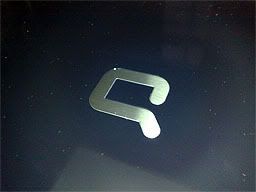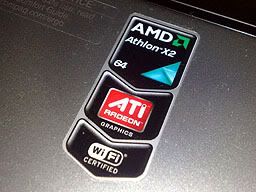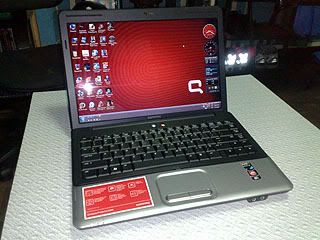My second notebook....
Several weeks ago I bought a new notebook computer to replace my aging Asus A9Rp. The Asus, while tough as nails and as reliable as a Toyota, was starting to get a bit long in the tooth, and compared to its contemporaries, getting to be a bit of a dinosaur.
While the Asus A9Rp is by no means a cutting edge notebook computer even when it was brand new, it was perfectly adequate for most computing purposes such as word processing, internet browsing, watching DVDs, and even gaming thanks to its built-in ATI Radeon™ Xpress 200M graphics. Where it does fall short, is in its size, and weight. It has a 15" screen with a 4:3 aspect ratio, so it's not widescreen. Not being widescreen, the notebook itself occupies a fairly big squarish footprint which inevitably makes it heavier than average at about 3.26 kilograms (7.17 lbs). With today's notebooks (and netbooks) sometimes weighing less than half that, I decided it was time for a change...and this time, other than price, weight was going to be factor. The notebook computer I chose was a Compaq Presario CQ40-107AU which was quite a steal at only P27,500.00 at Villman, P2,000.00 cheaper than the A9Rp which was also purchased new at Villman less than two years ago. Spec-wise, it runs rings around the Asus.
The notebook computer I chose was a Compaq Presario CQ40-107AU which was quite a steal at only P27,500.00 at Villman, P2,000.00 cheaper than the A9Rp which was also purchased new at Villman less than two years ago. Spec-wise, it runs rings around the Asus.
The CQ40-107AU is built around AMD's Puma platform, which combines an AMD dual-core Lion 64-bit processor with AMD's M780 chipset with integrated ATI Radeon HD 3200 graphics. In this particular model, the processor is an Athlon X2 QL-60 running at 1.9 GHz. Note that this is not a desktop Athlon X2 installed in a notebook. It's a true purpose-built mobile processor based on the K8 (desktop Athlon X2) with power-saving features from the K10 (desktop Phenom) built on a .065 micron process, running at a peak thermal design power of 35 watts. Granted, this is no match for an equivalent Core 2 Duo notebook as far as raw processing power is concerned, but it will definitely outperform any entry level Core 2 Duo-equipped notebook when it comes to 3D gaming thanks to the built-in ATI graphics. Then there's the price. The cheapest Core 2 Duo notebook I could find was an MSI Megabook S1313 which was being sold at P30,999.00. I was all set to purchase it, attracted by it's 13.3" widescreen footprint, never mind the sluggish Intel X3100 graphics. Of course, when the good folks at PC Express Virra Mall took almost an hour to figure out how to crack open the case to add another stick of RAM (and actually not even succeeding), I passed, not wanting all that hassle just to add another gig of memory. The next cheapest Core 2 Duo equipped notebook I could find was an Acer worth P36,900.00, which almost ten grand more expensive than the Presario. Clearly a no-brainer, particularly for a cheapskate like me.
Granted, this is no match for an equivalent Core 2 Duo notebook as far as raw processing power is concerned, but it will definitely outperform any entry level Core 2 Duo-equipped notebook when it comes to 3D gaming thanks to the built-in ATI graphics. Then there's the price. The cheapest Core 2 Duo notebook I could find was an MSI Megabook S1313 which was being sold at P30,999.00. I was all set to purchase it, attracted by it's 13.3" widescreen footprint, never mind the sluggish Intel X3100 graphics. Of course, when the good folks at PC Express Virra Mall took almost an hour to figure out how to crack open the case to add another stick of RAM (and actually not even succeeding), I passed, not wanting all that hassle just to add another gig of memory. The next cheapest Core 2 Duo equipped notebook I could find was an Acer worth P36,900.00, which almost ten grand more expensive than the Presario. Clearly a no-brainer, particularly for a cheapskate like me.
Of course the Presario wasn't the only AMD-based notebook I considered. For a moment I also liked the Acer Aspire 4530-801G16Mn, which boasted a 2.1 GHz AMD Turion Ultra X2 ZM-80 processor and Nvidia GeForce 9100M graphics for P33,600.00. However, concerns about the questionable durability of mobile Nvidia GPUs scared me away, more so if you searched for horror stories on the web, of which there are a lot. Apparently Nvidia has not been very forthcoming about the extent and prevalence of the defects, and they seem to span a very wide range of mobile and even desktop GPUs. Coincidentally, earlier this year I lost an Inno3D GeForce 6800LE AGP video card which showed symptoms basically identical to those exhibited by defective mobile GPUs, (weird columns of evenly spaced dots on Windows startup screens, crashing on 3D apps) and my GPU is a desktop model. And I've never had a video card break down on me before. In fact, I still have perfectly functioning Voodoo 2s, TNTs and even some ViRGEs lying around. Therefore, at this point in time, for me at least, I'm staying away from anything made by Nvidia.
So...the Compaq gets the nod. And here it is:

Key features include the aforementioned Athlon X2 QL-60 and M780 chipset with an integrated ATI Radeon HD 3200 GPU, a 14.1" widescreen display, 1 GB of RAM, a 160 GB Western Digital hard drive, a SuperMulti 8X DVD±R/RW with Double Layer Support and Altec Lansing speakers. Other features include virtually everything else you'll need, such as Wi-Fi, three USB 2.0 ports, LAN and modem ports, Bluetooth connectivity, a 5-in-1 card reader, video out and HDMI ports, and a built-in webcam and microphone, all in a package which weigh only 2.29 kilograms (5.038 lbs).
Like any other notebook, it does have its quirks. The first unit I received had a defective optical drive which wouldn't open. It was promptly replaced, even when the store was already closed (hats off to Villman Katipunan for the quick response, though I told them that if they didn't replace it immediately I would demand a refund).
Secondly, the CQ40-107AU only comes with FreeDOS, which is virtually useless, unless you insist on running, say, WordStar. It also does not "officially" support Windows XP. While there are ways of making XP run on this thing, some functionality does get lost, among others the function keys which adjust volume, brightness, etc. Not wanting to have any non-functioning controls I splurged and bought an OEM copy of Windows Vista Home Basic. It doesn't have the Windows Aero interface, but then again, I am a cheapskate. Vista or otherwise, it doesn't come with a driver CD, so you have to download the drivers from Compaq's website yourself. While not a big deal, it's somewhat a bit of a bother, when almost every other notebook manufacturer includes a CD with the drivers.
The standard 1 GB of RAM is pretty skimpy, especially when running Vista, so I upgraded it to 4 GB using a pair of 2 GB DDR2667 Kingston ValueRAM SODIMMs. And unlike the MSI S1313, you can upgrade the memory in matter of minutes. Unfortunately, I can't access all 4 GB due to the limitations of a 32-bit OS. In fact, I can only use 2,812 out of 4,096 MB. I guess have to save up for a 64-bit OS if I want to maximize the use of my memory.
The top of the notebook is in a smooth, glossy, piano-black finish which is pretty upscale in appearance, but collects more fingerprints than the NBI and PNP combined. The unit comes with a silicone-impregnated cloth to wipe it clean with, though.
Lastly, the CQ40 runs fairly hot. It does not really overheat mind you, the QL-60 just appears to run hotter normally than most other CPUs, idling at 60+ and working hard at around 80+ degrees C. A good notebook cooler is therefore a must for prolonged use in hot environments. And don't use it on your lap, unless you're willing to risk broiling your testicles...or unless you're a girl. :-)
In conclusion, the Compaq Presario CQ40-107AU is a cheap but feature-rich notebook, even though I had to pay extra for the OS and RAM upgrade. It's not the most powerful notebook, but it is a very well-rounded one, and it will do pretty much anything you ask it to do. I'm pretty much satisfied with it, and it will probably serve my needs for the next year or so. Well, at least until quad-core notebooks become mainstream...or in my case, affordable.
Comments